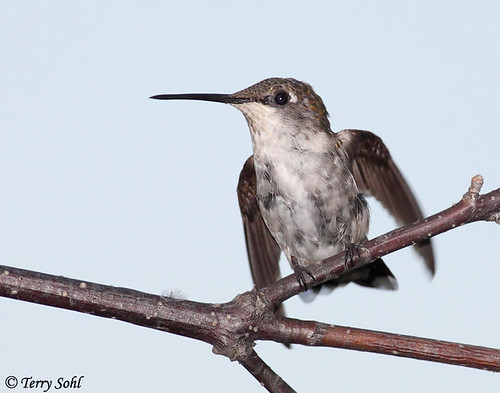tags: Ruby-throated Hummingbird, Archilochus colubris, birds, mystery bird, bird ID quiz
[Mystery bird] Moulting adult female Ruby-throated Hummingbird, Archilochus colubris, photographed in Brandon, South Dakota. [I will identify this bird for you in 48 hours]
Image: Terry Sohl, 12 August 2009 [larger view]
Photo taken with Canon 50D, 400 5.6L.
Please name at least one field mark that supports your identification.


It's a hummingbird. Identifying mark: no word sheet.
The comb and tissue paper gives it away...
It's a Ruby-throated Hummingbird. The field mark is the location - it's the only hummingbird I could find breeding in SD.
I agree that Ruby-throated is the only hummer that 'should' be in SD. But... hummers have been known to wander a very long way for such small birds. So let's look her over a bit more.
The white undersides rule out most of our southwestern specialties -- except Violet-crowned, which should have red on the bill and a much stronger contrast on the face. Calliope and all of the Selasphorus hummers should have extensive rufous below. Anna's has gray flanks with green spotting in all plumages. Costa's should have a white supercilium extending down past the auriculars, not the simple white spot behind the eye. This leaves us with Black-chinned and Ruby-throated. Telling females of these two apart is challenging even in the hand. The most notable field mark is in the shape of the primary tips, but those are in motion in the photo and probably not reliable as a result. Ruby-throated should have the more contrasting head pattern of the two, but I don't have the experience to interpret the photo in this light. About the only field mark I can see that might be useful here is the shape of the outer tail feathers. That seems to suggest Ruby-throated, as Les already pointed out is the one to be expected. However, if this bird were out of range, I don't think I could feel comfortable identifying it to species.
psweet, you rock! What a nice little primer on what to look for in hummingbirds. Thanks.
Since it's vagrant hummingbird season, let's work through this one step by step:
There's no visible rufous in the plumage nor a distinct demarcation between gorget and breast, so that eliminates Broad-tailed, a rare breeder in southwestern SD, and potential vagrants Calliope, Rufous, and Allen's. That leaves the gray and green group: Ruby-throated, the state's main breeding hummingbird as Les points out, and potential vagrants Black-chinned, Anna's, and Costa's.
The bird is too slim, pale-bellied, and clear-throated for Anna's and too dark-faced and flat-throated for Costa's. Its outer tail feathers appear too broad and straight for Costa's as well but consistent with Ruby-throated or Black-chinned.
The virtually unmarked throat is consistent with a female, and the worn plumage condition and apparent heavy body molt suggest an adult. Female hummingbirds' bills are longer on average than males', and Black-chinneds' bills are longer on average than Ruby-throateds'. This bird's relatively short bill is consistent with a female Ruby-throated, and her blurry primaries appear narrow and straight enough to support this ID.
hrm. the photographer says it's a fledgling, but it is possible he made a mistake. i'll check with him to confirm.
The tips of R5 appear rounded enough that a juvenile female some weeks out of the nest is a possibility, but fledglings (still dependent on their mothers) should have smoother, fresher plumage with conspicuous buffy edges on the darker feathers, as in this juvenile male. (Bill growth is usually not complete before fledging, which makes bill length less reliable for ID of a very young hummingbird in the absence of its mother's field marks.)
I have no idea what it is, but I'm learning a lot from reading the comments.
I'm learning a lot too! And I took the photo in my own backyard!! You folks have a much better grasp of hummingbird identification than I do!!
@Bardiac:
Thanks for the post, but I have to admit I just read the books real carefully. Sheri gets her hands dirty banding them. If it comes down to it -- listen to her.
As far as the age, I can imagine a situation where a bunch of fledglings leave the nest, and the female is right with them. Figuring out which was which could be awfully difficult.
Thanks Grrl for the mystery bird post. Thanks also to Terry for the photo and Sheri for the excellent lesson. Being an avid birder and photographer myself, I love reading the posts and learning about all the subtleties in bird ID with different plumages during growth stages and breeding.